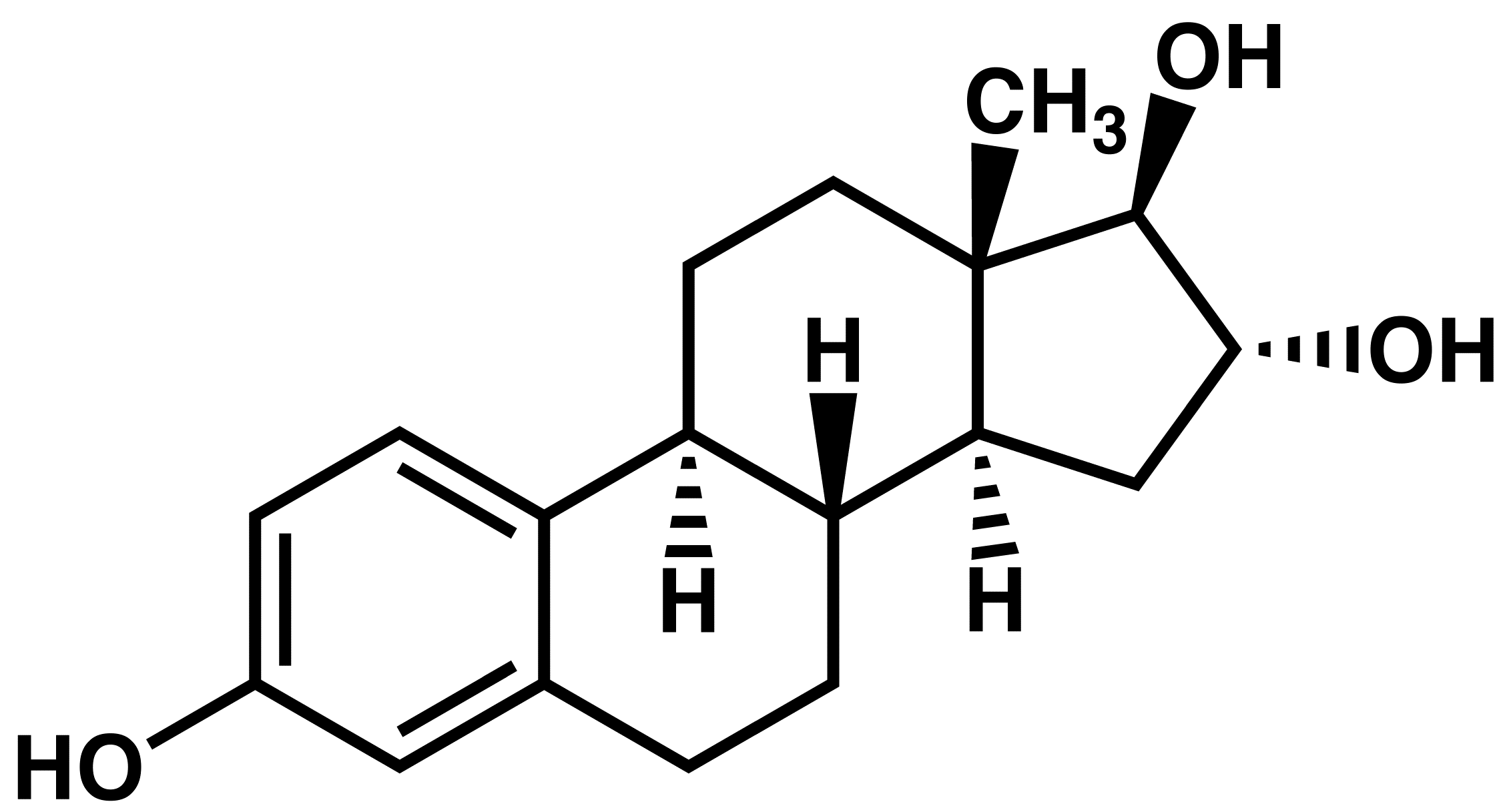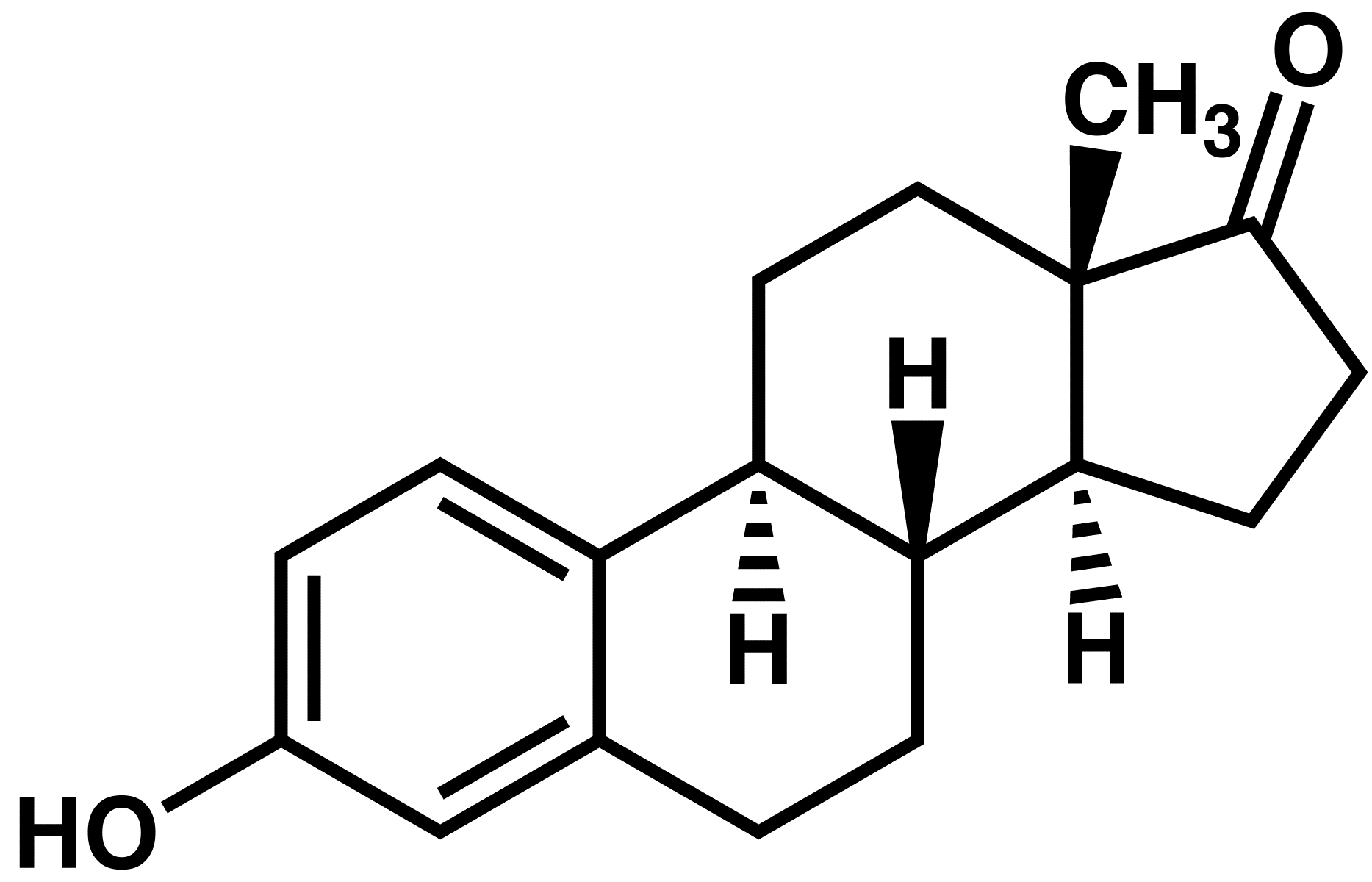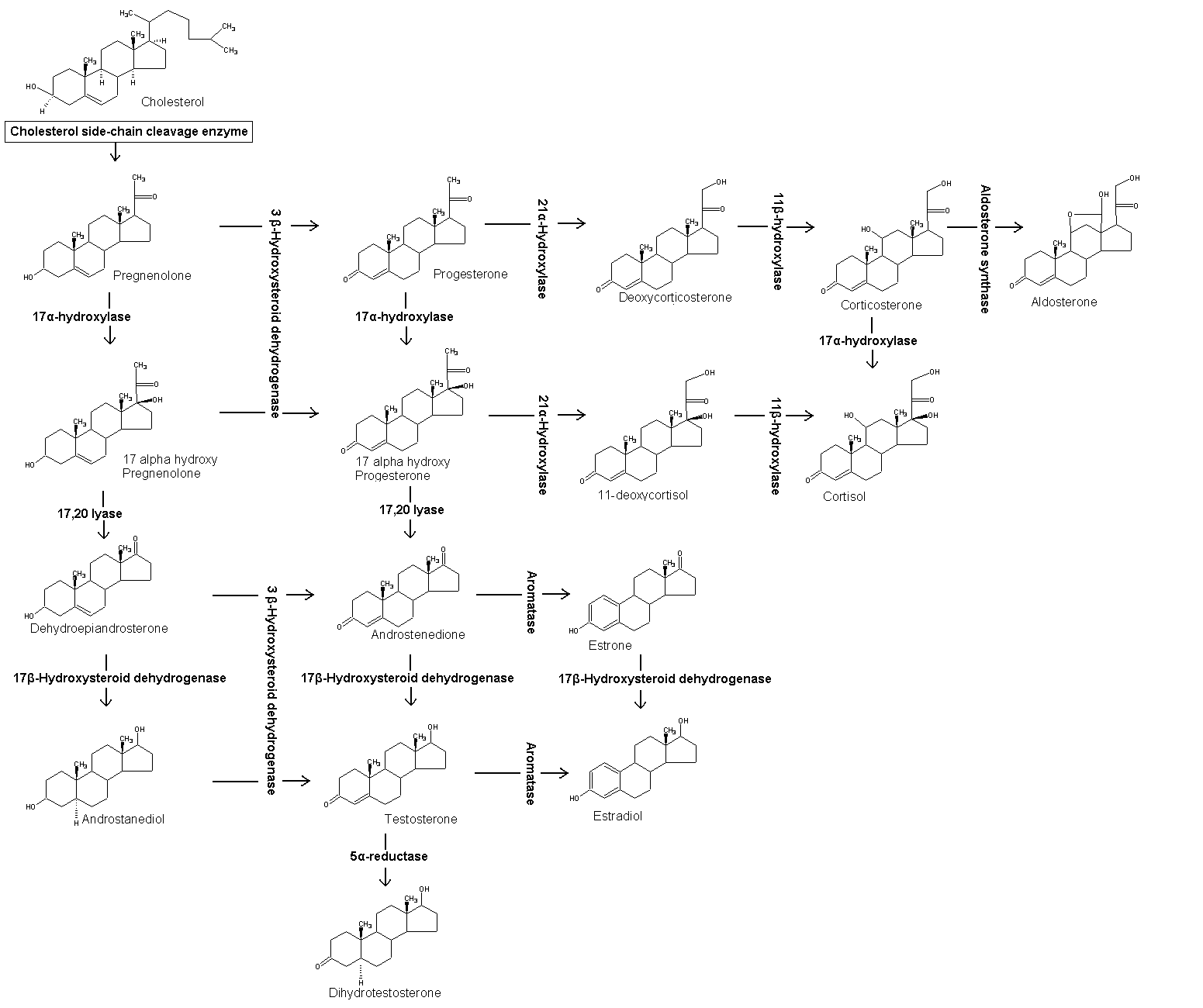Estrogen



|
WikiDoc Resources for Estrogen |
|
Articles |
|---|
|
Most recent articles on Estrogen |
|
Media |
|
Evidence Based Medicine |
|
Clinical Trials |
|
Ongoing Trials on Estrogen at Clinical Trials.gov Clinical Trials on Estrogen at Google
|
|
Guidelines / Policies / Govt |
|
US National Guidelines Clearinghouse on Estrogen
|
|
Books |
|
News |
|
Commentary |
|
Definitions |
|
Patient Resources / Community |
|
Directions to Hospitals Treating Estrogen Risk calculators and risk factors for Estrogen
|
|
Healthcare Provider Resources |
|
Causes & Risk Factors for Estrogen |
|
Continuing Medical Education (CME) |
|
International |
|
|
|
Business |
|
Experimental / Informatics |
Editor-In-Chief: C. Michael Gibson, M.S., M.D. [1]
Overview
Estrogens (alternative spellings: oestrogens or œstrogens) are a group of steroid compounds, named for their importance in the estrous cycle, and functioning as the primary female sex hormone.
Estrogens are used as part of some oral contraceptives, in estrogen replacement therapy of postmenopausal women, and in hormone replacement therapy for transwomen.
Like all steroid hormones, estrogens readily diffuse across the cell membrane; inside the cell, they interact with estrogen receptors.[1]
Types of estrogen
The three major naturally occurring estrogens in women are estradiol, estriol, and estrone. In the body these are all produced from androgens through actions of enzymes.
- From menarche to menopause the primary estrogen is 17β-estradiol. In postmenopausal women more estrone is present than estradiol.
- Estradiol is produced from testosterone and estrone from androstenedione.
- Estrone is weaker than estradiol.
Premarin, a commonly prescribed estrogenic drug, contains the steroidal estrogens equilin and equilenin, in addition to estrone sulfate. A range of synthetic and natural substances have been identified that also possess estrogenic activity.[2] Synthetic substances of this kind are known as xenoestrogens, plant products with estrogenic activity are called phytoestrogens, and those produced by fungi are known as mycoestrogens. Unlike estrogens produced by mammals, these substances are not necessarily steroids.
Estrogen production

Testosterone is synthesized during steroidogenesis, with cholesterol as the starting molecule.
Estrogen is produced primarily by developing follicles in the ovaries, the corpus luteum, and the placenta. Follicle-stimulating hormone (FSH) and luteinizing hormone (LH) stimulate the production of estrogen in the ovaries. Some estrogens are also produced in smaller amounts by other tissues such as the liver, adrenal glands, and the breasts. These secondary sources of estrogen are especially important in postmenopausal women.
Synthesis of estrogens starts in theca interna cells in the ovary, by the synthesis of androstenedione from cholesterol. Androstenedione is a substance of moderate androgenic activity. This compound crosses the basal membrane into the surrounding granulosa cells, where it is converted to estrone or estradiol, either immediately or through testosterone. The conversion of testosterone to estradiol, and of androstenedione to estrone, is catalyzed by the enzyme aromatase.
Estradiol levels vary through the menstrual cycle, with levels highest just before ovulation.
Functions
While estrogens are present in both men and women, they are usually present at significantly higher levels in women of reproductive age. They promote the development of female secondary sex characteristics, such as breasts, and are also involved in the thickening of the endometrium and other aspects of regulating the menstrual cycle. In males estrogen regulates certain functions of the reproductive system important to the maturation of sperm [3] [4] and may be necessary for a healthy libido.[5]. Furthermore, there are several other structural changes induced by estrogen, in addition to other functions.
- Structural
- promote formation of female secondary sex characteristics
- accelerate height growth
- accelerate metabolism (burn fat)
- reduce muscle mass
- stimulate endometrial growth
- increase uterine growth
- maintenance of vessel and skin
- reduce bone resorption, increase bone formation
- morphic change (endomorphic -> mesomorphic -> ectomorphic)
- protein synthesis
- increase hepatic production of binding proteins
- coagulation
- increase circulating level of factors 2, 7, 9, 10, antithrombin III, plasminogen
- increase platelet adhesiveness
- Lipid
- increase HDL, triglyceride, height growth
- decrease LDL, fat depositition
- Fluid balance
- salt (sodium) and water retention
- increase growth hormone
- increase cortisol, SHBG
- gastrointestinal tract
- reduce bowel motility
- increase cholesterol in bile
- Melanin
- increase pheomelanin, reduce eumelanin
- Cancer
- support hormone-sensitive breast cancers (see section below)
- Lung function
On the other hand, sexual desire rather depend on androgen levels than for estrogen levels.[7]
Role in cancer
About 80% of breast cancers, once established, rely on supplies of the hormone estrogen to grow: they are known as hormone-sensitive or hormone-receptor-positive cancers.[8] Suppression of production in the body of estrogen is a treatment for these cancers.
Medical applications
Since estrogen circulating in the blood can negatively feed-back to reduce circulating levels of FSH and LH, most oral contraceptives contain a synthetic estrogen, along with a synthetic progestin. Even in men, the major hormone involved in LH feedback is estradiol, not testosterone.
As more fully discussed in the article on Hormone replacement therapy , estrogen and other hormones are given to postmenopausal women in order to prevent osteoporosis as well as treat the symptoms of menopause such as hot flashes, vaginal dryness, urinary stress incontinence, chilly sensations, dizziness, fatigue, irritability, and sweating. Fractures of the spine, wrist, and hips decrease by 50-70% and spinal bone density increases by ~5% in those women treated with estrogen within 3 years of the onset of menopause and for 5-10 years thereafter.
Before the specific dangers of conjugated equine estrogens were well understood, standard therapy was 0.625 mg/day of conjugated equine estrogens (such as Premarin). There are, however, risks associated with conjugated equine estrogen therapy. Among the older postmenopausal women studied as part of the Women's Health Initiative (WHI), an orally-administered conjugated equine estrogen supplement was found to be associated with an increased risk of dangerous blood clotting. The WHI studies used one type of estrogen supplement, a high oral dose of conjugated equine estrogens (Premarin alone and with medroxyprogesterone acetate as PremPro).[9]
In a study by the NIH, esterified estrogens were not proven to pose the same risks to health as conjugated equine estrogens. Hormone replacement therapy has favorable effects on serum cholesterol levels, and when initiated immediately upon menopause reduces the incidence of cardiovascular disease. Estrogen has a protector effect on atherosclerosis : it lowers LDL and triglycerides, it raises HDL levels and has endothelial vasodilatation properties plus an anti-inflammatory component.
Research is underway to determine if risks of estrogen supplement use are the same for all methods of delivery. In particular, estrogen applied topically may have a different spectrum of side-effects than when administered orally,[10] and transdermal oestrogens do not affect clotting as they are absorbed directly into the systemic circulation, avoiding first-pass metabolism in the liver. This route of administration is thus preferred in women with a history of thrombo-embolic disease.
Estrogen is also used in the therapy of vaginal atrophy, hypoestrogenism (as a result of hypogonadism, castration, or primary ovarian failure), amenorrhea, dysmenorrhea, and oligomenorrhea. Estrogens can also be used to suppress lactation after child birth.
Hormone-receptor-positive breast cancers are treated with drugs which suppress production in the body of estrogen.[11] This technique, in the context of treatment of breast cancer, is known variously as hormonal therapy, hormone therapy, or anti-estrogen therapy (not to be confused with hormone replacement therapy). Certain foods such as soy may also suppress the effects of estrogen and are used as an alternative to hormone therapy.[12]
In humans and mice, estrogen promotes wound healing.[13]
At one time, estrogen was used to induce growth attenuation in tall girls.[14] Recently, estrogen-induced growth attenuation was used as part of the controversial Ashley Treatment to keep a developmentally disabled girl from growing to adult size.[15]
Under certain circumstances, estrogen may also be used in males for treatment of prostate cancer.[16]
Most recently, estrogen has been used in experimental research as a way to treat patients suffering from bulimia nervosa, in addition to Cognitive Behavioral Therapy, which is the established standard for treatment in bulimia cases. The estrogen research hypothesizes that the disease may be linked to a hormonal imbalance in the brain.[17]
Estrogen has also been used in studies which indicate that it may be an effective drug for use in the treatment of traumatic liver injury.[18]
Health risks and warning labels
The labeling of estrogen-only products in the U.S. includes a boxed warning that unopposed estrogen (without progestagen) therapy increases the risk of endometrial cancer.
Based on a review of data from the WHI, on January 8, 2003 the FDA changed the labeling of all estrogen and estrogen with progestin products for use by postmenopausal women to include a new boxed warning about cardiovascular and other risks. The estrogen-alone substudy of the WHI reported an increased risk of stroke and deep vein thrombosis (DVT) in postmenopausal women 50 years of age or older and an increased risk of dementia in postmenopausal women 65 years of age or older using 0.625 mg of Premarin conjugated equine estrogens (CEE). The estrogen-plus-progestin substudy of the WHI reported an increased risk of myocardial infarction, stroke, invasive breast cancer, pulmonary emboli and DVT in postmenopausal women 50 years of age or older and an increased risk of dementia in postmenopausal women 65 years of age or older using PremPro, which is 0.625 mg of CEE with 2.5 mg of the progestin medroxyprogesterone acetate (MPA).[19][20][21]
Estrogens in cosmetics
Some hair shampoos on the market include estrogens and placental extracts; others contain phytoestrogens. There are case reports of young children developing breasts after exposure to these shampoos. [22] These products are often marketed to African-American consumers.[23]
On September 9, 1993, the FDA determined that not all topically-applied hormone-containing drug products for OTC human use are generally recognized as safe and effective and are misbranded. An accompanying proposed rule deals with cosmetics, concluding that any use of natural estrogens in a cosmetic product makes the product an unapproved new drug and that any cosmetic using the term "hormone" in the text of its labeling or in its ingredient statement makes an implied drug claim, subjecting such a product to regulatory action.[24]
In addition to being considered misbranded drugs, products claiming to contain placental extract may also be deemed to be misbranded cosmetics if the extract has been prepared from placentas from which the hormones and other biologically active substances have been removed and the extracted substance consists principally of protein. The FDA recommends that this substance be identified by a name other than "placental extract" and describing its composition more accurately because consumers associate the name "placental extract" with a therapeutic use of some biological activity.[24]
History
The existence and effects of estrogen were established from 1923 to 1938 in which the formulation was led by a group of scientists instead of pharmaceutical companies. Thereafter, the market for hormonal drug research opened up.
The “first orally effective estrogen”, Emmenin, derived from the late-pregnancy urine of Canadian women, was introduced in 1930 by Collip and Ayerst Laboratories . Estrogens are not water-soluble and cannot be given orally, but the urine was found to contain estriol glucuronide which is water soluble and becomes active in the body after hydrolization.
Scientists continued to search for new sources of estrogen because of concerns associated with the practicality of introducing the drug into the market. At the same time, a German pharmaceutical drug company, formulated a similar product as Emmenin that was introduced to German women to treat menopausal symptoms.
In 1938, British scientists obtained a patent on a newly formulated nonsteroidal estrogen, Diethylstilbestrol (DES), that was cheaper and more powerful than the previously manufactured estrogens. Soon after, concerns over the side effects of DES were raised in scientific journals while the drug manufacturers came together to lobby for governmental approval of DES. It was only until 1941 when estrogen therapy was finally approved by the Food and Drug Administration (FDA) for the treatment of menopausal symptoms. [25]
See also
References
- ↑ Nussey and Whitehead: Endocrinology, an integrated approach, Taylor and Francis 2001
- ↑ Fang H, Tong W, Shi L, Blair R, Perkins R, Branham W, Hass B, Xie Q, Dial S, Moland C, Sheehan D (2001). "Structure-activity relationships for a large diverse set of natural, synthetic, and environmental estrogens". Chem Res Toxicol. 14 (3): 280–94. PMID 11258977.
- ↑ Science Blog - Estrogen Linked To Sperm Count, Male Fertility
- ↑ Science News Online (12/6/97): Estrogen's Emerging Manly Alter Ego
- ↑ http://www.phimr.monash.edu.au/news/media_releases/estrogen_vital_for_male_sex_drive.htm - 20k
- ↑ Massaro D, Massaro GD (2004). "Estrogen regulates pulmonary alveolar formation, loss, and regeneration in mice". American Journal of Physiology. Lung Cellular and Molecular Physiology. 287 (6): L1154–9. PMID 15298854 url=http://ajplung.physiology.org/cgi/content/full/287/6/L1154.
- ↑ Warnock JK, Swanson SG, Borel RW, Zipfel LM, Brennan JJ. (2005). "Combined esterified estrogens and methyltestosterone versus esterified estrogens alone in the treatment of loss of sexual interest in surgically menopausal women". Menopause. 12 (4): 374–84. PMID 16037752.
- ↑ Hormonal Therapy
- ↑ Menopausal Hormone Therapy Information - NIH
- ↑ Effects of transdermal estrogen replacement therapy on cardiovascular risk factors (Treat Endocrinol.) - PMID 16396517
- ↑ Hormonal Therapy - breastcancer.org
- ↑ Kurzer, Mindy S. (2002). "Hormonal Effects of Soy in Premenopausal Women and Men". J. Nutr. 132 (3): 570–573. PMID 11880595. Retrieved 2007-03-27.
- ↑ http://www.woundsresearch.com Feature: Sex Hormones and Wound Healing - Desiree May Oh, MD, and Tania J. Phillips, MD
- ↑ Joyce M. Lee and Joel D. Howell. Tall Girls: The Social Shaping of a Medical Therapy Archives of Pediatrics & Adolescent Medicine, Vol. 160 No. 10, October 2006.
- ↑ Daniel F. Gunther and Douglas S. Diekema. Attenuating Growth in Children With Profound Developmental Disability. Archives of Pediatrics & Adolescent Medicine, Vol. 160 No. 10, October 2006.
- ↑ The evolving role of estrogen therapy in prostate cancer (Clin. Prostate Cancer.) PMID 15046698
- ↑ Bulimia May Result from Hormonal Imbalance
- ↑ Hsieh, Ya-Ching (2007-04-01). "G Protein-Coupled Receptor 30-Dependent Protein Kinase A Pathway Is Critical in Nongenomic Effects of Estrogen in Attenuating Liver Injury after Trauma-Hemorrhage". Am. J. Pathol. 170: 1210–1218. doi:10.2353/ajpath.2007.060883. PMID 17392161. Retrieved 2007-04-03. Text " issue 4 " ignored (help); Unknown parameter
|coauthors=ignored (help) - ↑ FDA (2003, Jan 8). "FDA Approves New Labels for Estrogen and Estrogen with Progestin Therapies for Postmenopausal Women Following Review of Women's Health Initiative Data". Retrieved 2006-10-26. Check date values in:
|date=(help) - ↑ Kolata, Gina (2003, Jan 9). "F.D.A. Orders Warning on All Estrogen Labels". The New York Times. Retrieved 2006-10-26. Check date values in:
|date=(help) - ↑ NLM (2006, Apr 1). "IMPORTANT WARNING". Drug Information: Estrogen. MedlinePlus. Retrieved 2006-10-26. Check date values in:
|date=(help) - ↑ Preschool Puberty, and a Search for the Causes, The New York Times, 17 October 2006.
- ↑ Su-Ting et al. Hormone-Containing Hair Product Use in Prepubertal Children. Pediatrics & Adolescent Medicine, vol 156, p. 85. January 2002. PMID 11772198
- ↑ 24.0 24.1 FDA (1995, Feb). "Products containing estrogenic hormones, placental extract or vitamins". Guide to Inspections of Cosmetic Product Manufacturers. Retrieved 2006-10-24. Check date values in:
|date=(help) - ↑ Rothenberg, Carla J. (2005-04-25). "The Rise and Fall of Estrogen Therapy: The History of HRT" (PDF). Retrieved 2006-10-27.
See also
- Female
- Atrophic vaginitis
- Endocrinology
- Equol
- Equilin
- Estradiol
- Estrogen receptor
- Hormone Replacement Therapy
- Progesterone
- Progestin
- Testosterone
ar:إستروجين ca:Estrogen cs:Estrogen da:Østrogen de:Östrogen dv:އެސްޓްރަޖަން el:Οιστρογόνο id:Estrogen is:Estrógen it:Estrogeno he:אסטרוגן lt:Estrogenai mk:Естрогени хормони nl:Oestrogeen ko:에스트로겐 no:Østrogen su:Éstrogén fi:Estrogeeni sv:Östrogen